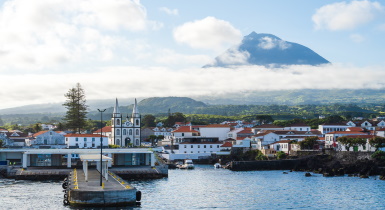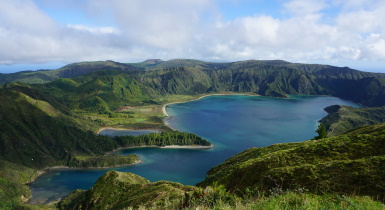The judicial capital - Angra do Heroismo - is located on Terceira Island. Angra is a magnificent port city and a UNESCO World Heritage Site rich in Renaissance-influenced architecture. A stop here was obligatory for trading ships sailing between the New World, the East Indies and Europe.
Sao Miguel, the largest of the Azores islands, is also called “the Green Island” on account of its great abundance of tea plantations nestled between post-volcanic lakes and craters. Its omnipresent, impressive flora gives Sao Miguel an almost tropical atmosphere – comparisons with Hawaii are not completely superficial! Sao Miguel is home to twin crater lake of Sete Cidades, the most photographed site in the Azores. It also offers the most in terms of accommodation and activities, while still retaining a gentle, laid-back atmosphere. The main city on the island is Ponta Delgada, which is the executive capital of the Azores.
Pico, at 3000 years old, is the youngest island in the Azores. It is known locally as the “black” island, and centres on Pico Peak, a huge dormant volcano and the highest peak on the islands (2351m). A trek to summit is a highlight both for the pleasure of the trek itself and for the fabulous views. On the north coast of the island, locals have built homes from black basalt adding to the atmosphere of this unique island. The south of the island is lush and green and here can be found the famous vineyards which are now a UNESCO world heritage site. Pico was once the centre of the whaling industry and remains one of the best places in the world for whale-watching.
Faial Island (also called Blue Island because of the gorgeous blue hydrangeas which flourish here) is just a 30 minute ferry ride from Pico and is one of the smaller islands of the archipelago. Horta is the main town and port and is one of the prettiest towns on the islands with a backdrop of green undulating hills and a very pretty harbour. This is a lovely town to explore leisurely – allow at least half a day. The island also has some dramatic volcanic landscapes including the site of Capelinhas, which erupted in 1957.
Sao Jorge Island, although slightly off the beaten track, is well worth a visit on longer itineraries to the Azores. Sao Jorge has a central range of hills running virtually the entire length of the island, incredibly steep cliffs, tiny villages and fajas (small plains usually formed by lava flows and forming rich wetlands and lagoons). The eastern side of the island is a protected area because of its interesting birdlife, which includes Cory’s shearwaters, amongst many other seabirds.
Flores Island is the westernmost island of the Azores and Europe! This tiny island (approx 55 square miles) is now a UNESCO Biosphere reserve. As the name suggests, the island is rich with plants and flowers, many of which have been seeded by migrating birds. Flores is spectacularly beautiful and rugged with high peaks, sheer cliffs, coastal caves, lakes, waterfalls and valleys. The central plateau is between 600-700 metres above sea level and rich in peatlands which are important natural habitats for numerous birds, plants and insects.
Do contact us if you would like a tailormade itinerary to any of the beautiful Azores islands.





